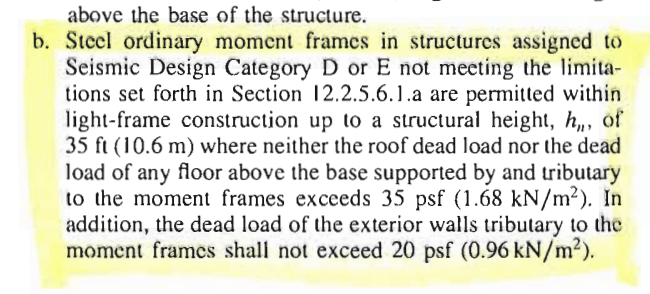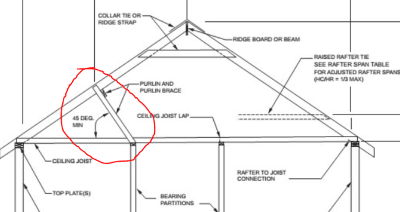Good morning. I have been an EIT at my firm for the last 2 years and am working toward my PE license. I have worked on a number of residential projects similar to the one shown below with very tall (20') great rooms at the rear of the home. Most of our projects are SDC D. For the lateral design on projects like this our first approach is to see if the other walls on the upper floor can handle all of the lateral loads. This approach often doesn't work (plate height differences, the other upper floor walls are cantilevered past the main floor walls below, the shear walls just aren't enough to handle the load, etc.), which results in a special moment frame (SMF) being designed at the great room.
As I gain more experience I am digging into the code books more and more, and what I'm finding in there doesn't sit right with me compared to how our firm designs these SMFs. We do not provide the required lateral bracing as required by code. We follow the prequalified RBS connection procedure for the beam-to-column connection, but we do not design the continuity plates for the "maximum probable moment" per the code. Rather, we design it for the calculated moment from our loadings on the frame. I have brought these concerns to my boss (the owner of the company). He says that we don't do the bracing because the gravity loads on the beam are small enough that it won't matter, and also that none of our competitors are doing the bracing either. He says we don't use the maximum probably moment because, again, our loadings are so small that the maximum probably moment will never happen. These explanations aren't satisfactory to me, because as I read the code these things are required no matter what. In my opinion if we're trying to design a SMF without the bracing and without following the codified procedure for the RBS connection then we aren't really designing a SMF.
I understand that the code can often be onerous, but these explanations don't sit right with me because essentially they boil down to "ignore the code." So my questions are these:
1. What is your opinion on SMFs without lateral bracing, and RBS connections without using the maximum probably moment?
2. Are there other viable lateral designs for these walls? In reading the code I don't believe that an IMF or OMF could be justified due to these frames being more than 1-story, height restrictions, load restrictions, etc. I have done some reading on the Simpson Moment Frames, but I don't believe that anyone in our market is using them.
3. Is "our competitors do that so that's what we'll do" good logic? If there is ever an issue with these frames I doubt that that argument will hold water. But maybe my boss is right and the loads are so small that these things I'm worried about will never happen in a million years.
I'd be grateful for any advice or suggestions you could give. Thank you!

As I gain more experience I am digging into the code books more and more, and what I'm finding in there doesn't sit right with me compared to how our firm designs these SMFs. We do not provide the required lateral bracing as required by code. We follow the prequalified RBS connection procedure for the beam-to-column connection, but we do not design the continuity plates for the "maximum probable moment" per the code. Rather, we design it for the calculated moment from our loadings on the frame. I have brought these concerns to my boss (the owner of the company). He says that we don't do the bracing because the gravity loads on the beam are small enough that it won't matter, and also that none of our competitors are doing the bracing either. He says we don't use the maximum probably moment because, again, our loadings are so small that the maximum probably moment will never happen. These explanations aren't satisfactory to me, because as I read the code these things are required no matter what. In my opinion if we're trying to design a SMF without the bracing and without following the codified procedure for the RBS connection then we aren't really designing a SMF.
I understand that the code can often be onerous, but these explanations don't sit right with me because essentially they boil down to "ignore the code." So my questions are these:
1. What is your opinion on SMFs without lateral bracing, and RBS connections without using the maximum probably moment?
2. Are there other viable lateral designs for these walls? In reading the code I don't believe that an IMF or OMF could be justified due to these frames being more than 1-story, height restrictions, load restrictions, etc. I have done some reading on the Simpson Moment Frames, but I don't believe that anyone in our market is using them.
3. Is "our competitors do that so that's what we'll do" good logic? If there is ever an issue with these frames I doubt that that argument will hold water. But maybe my boss is right and the loads are so small that these things I'm worried about will never happen in a million years.
I'd be grateful for any advice or suggestions you could give. Thank you!






